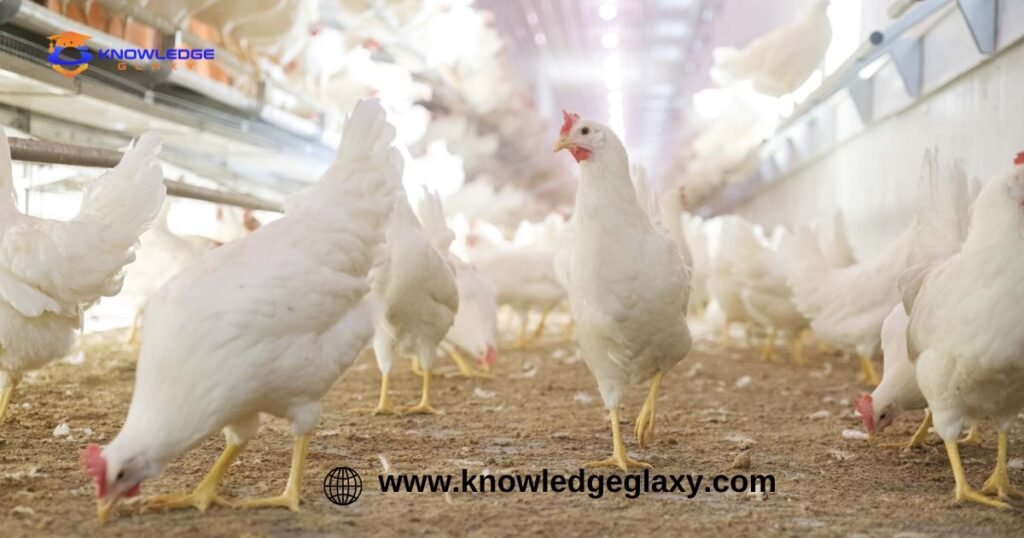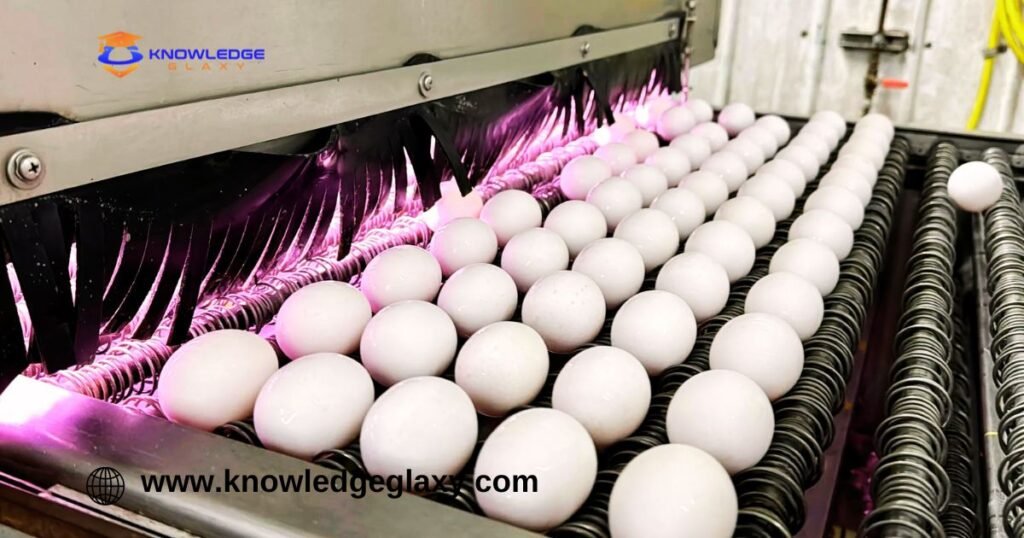Avian Influenza in Poultry – A Complete Guide
Avian influenza egg, also known as bird flu, is a highly contagious viral disease that can infect domestic poultry as well as wild birds. Avian influenza viruses are classified into low pathogenicity (LPAI) and high pathogenicity (HPAI) strains based on the severity of illness they cause in birds. An avian influenza egg outbreak can wreak havoc in the poultry industry leading to huge economic losses from high mortality rates in birds. Understanding the disease, how it spreads, its symptoms in birds, and preventative measures can help poultry farmers reduce the impact of outbreaks.
Overview of Avian Influenza
Avian influenza (AI) is caused by type A influenza viruses that have adapted to aquatic bird species like ducks and geese, which are the natural reservoir of these viruses. When LPAI viruses circulate among poultry flocks, they can mutate into HPAI viruses which are extremely infectious and fatal for chickens, turkeys, and other domesticated birds.
HPAI outbreaks pose the biggest risk as the high death rates of up to 100% can cause devastating economic consequences from massive culling of infected flocks. The most notable avian influenza virus subtype H5N1 first emerged in Chinese poultry in 1996 and has spread globally in periodic epizootics and epidemics transmitted through wild migratory bird routes.
Besides the economic impacts of trade restrictions and reduced consumption of poultry products during outbreaks, avian influenza viruses like H5N1 also pose risks to human health and have pandemic potential if the virus mutates to easily transmit between people.
Read More: Avian Influenza

How Avian Influenza Spreads in Birds
Avian influenza virus transmission occurs via:
- Direct contact – Between infected and healthy birds through respiratory secretions or feces
- Indirect contact – Through equipment, cages, clothing, feed, water, transportation vehicles contaminated with virus
- Airborne spread – Virus shed in respiratory droplets or feather dander can spread by air currents to birds nearby
Migratory waterfowl like wild ducks can introduce LPAI viruses to domestic poultry through shared water sources or surfaces contaminated by their droppings. The virus then spreads rapidly infecting chickens, turkeys, and quail through their high-density confinement in commercial facilities.
Human spread is very rare and restricted to close, prolonged unprotected exposure to infected birds or environments contaminated by their bodily discharge. Proper cooking destroys avian influenza viruses in poultry meat and eggs.
Symptoms of Avian Influenza Virus Infection in Birds
Symptoms of AI can vary greatly based on the virulence of the strain:
In LPAI infections
- Decreased energy, movement, and feed intake
- Ruffled feathers, respiratory distress
- Drop in egg production
- Mild diarrhea
In HPAI infections
- Sudden death with few prior symptoms
- Nearly 100% mortality in some outbreaks
- Complete drop in egg production
- Lethargy, neurological signs
- Difficulty breathing, severe diarrhea, swelling around the eyes
Unfortunately, vaccine efficacy is often limited in preventing illness from constantly evolving influenza viruses. This makes awareness and early reporting of suspicious avian influenza symptoms in birds critical for rapid outbreak response.
Poultry owners should be vigilant authorities about unusual spikes in deaths, steep declines in egg production exceeding expectations, or disproportionate disease spread between flocks. Authorized veterinarians conduct diagnostics like PCR, antigen, or antibody detection tests to test for bird flu in chickens and confirm AI infection.
How to Prevent Avian Influenza in Poultry
Preventing the initial introduction and spread of avian influenza is key as control is extremely challenging in dense, confined commercial poultry housing with thousands of susceptible birds.
Biosecurity Measures
Farm owners and workers should be trained in biosecurity principles and perform disinfection routines for:
- Personnel clothing, footwear
- Egg trays, crates
- Tools, equipment
- Transportation vehicles
Other vital biosecurity measures include:
- Perimeter fencing around poultry houses
- Sanitization footbaths or wheel dips at entrances
- Access restriction for non-essential visitors
- Showering before entering and exiting areas where birds are kept
Vaccination
Vaccinating birds against prevailing regional AI virus strains can reduce viral shedding and mortality. However avian influenza treatment through vaccination has limitations against emerging drift variant virus strains. Most countries employ vaccination judiciously based on active surveillance and risk level guided by international authorities.
In the US, HPAI vaccines are not permitted for routine preventive use. But can be allowed under emergency provisions during outbreaks. China and some Asian countries regularly use inactivated AI vaccines to help control the endemicity of the virus.
Experts debate the cost-benefit ratio of vaccination against unpredictable updates in circulating influenza subtypes. This influences decisions to include it as part of national AI prevention policies along with surveillance, education, rapid containment, and disinfection protocols.

Outbreak Management, Surveillance and Response
Early warning surveillance helps characterize emerging avian influenza in poultry threats by:
- Type of virus stain (H5N1, H7N9, etc.)
- The severity of the illness caused
- Mutation rates
- Potential species jump
It guides rapid coordinated decisions on implementing control measures like:
- Quarantining and Stamping out – Culling flocks infected or exposed to the virus
- Movement restrictions on poultry products
- Temporary emergency vaccination if permitted
- Cleaning and disinfecting affected premises as per protocol
The Food and Agriculture Department of the UN along with the World Organization for Animal Health provide guidance to national veterinary services for managing avian influenza.
Most countries have detailed avian influenza control programs for outbreak prevention and rapid response. This requires collaborative coordination between farmers, private industry partners, diagnostic services, and state veterinary, wildlife, and public health departments.
The Economic Impact of Avian Influenza
Avian influenza outbreaks can have devastating economic consequences on the poultry industry from:
- High mortality rates in infected flocks
- Mass culling of birds to contain outbreak spread
- Trade bans by countries on the import of poultry products
These add up to huge losses for poultry farmers, integrators, distributors, and exporters. Governments also bear substantial costs for surveillance, testing, culling, disposals, indemnity schemes, and public health preparedness.
Mortality Losses
High pathogenic avian influenza (HPAI) strains are extremely lethal for commercial chickens and turkeys. Some isolates like H5N1 have killed 100% of infected flocks within 48 hours in initial outbreaks.
While the initial introduction of the HPAI virus may be limited to a single farm, delays in detection and swift containment action allow further spread to surrounding farms. Clusters of infected premises have been rapidly detected even with intense control efforts.
Depopulation through mass culling of flocks on infected farms and dangerous contact sites is standard protocol to halt virus transmission. However, this emergency procedure leads to overnight loss of inventory for poultry businesses without the opportunity to limit financial impacts.
Farmers are compensated through government and industry-supported indemnity programs. But rating caps per bird apply and compensation may not match unrealized future production value.
Trade Barriers
Poultry exporters face the biggest economic brunt as trade partners swiftly impose import bans from affected countries during HPAI epidemics. These restrictions remain until outbreak control is declared leading to profit losses for months to years.
Domestically also, consumer demand is impacted by fears of infection which temporarily reduces poultry meat and egg purchases. Targeted public awareness campaigns are required to ensure the safety of properly cooked products.
Before the initial emergence of China’s virulent H5N1 strain in 1996, their annual domestic poultry industry growth rate was over 10% fueled by surging exports. Over $90 billion in economic damages occurred in the first decade of dealing with the endemic virus through recurring outbreak response expenditures and trade suspensions.
Global Persistence of H5N1 Avian Influenza
The reasons for H5N1 HPAI’s global persistence over decades include:
Genetic Mutability
Being ribonucleic acid (RNA) viruses, influenza viruses evolve through genetic drifts by accumulating random mutations and genetic shifts by exchanging RNA segments between strains during mixed infections. Avian influenza Egg This enables perpetuation in diverse hosts and climate conditions.
H5N1 has established reservoir pools and split into many regionally and host-adapted lineages. Recombinant genetic clusters pose ongoing threats.
Reintroduction Via Migratory Birds
The virus is maintained in certain wild aquatic bird populations which enables long-distance spread through migratory routes. Areas at risk of introduced outbreaks often involve sites where wild and domestic birds intermingle such as:
- Outdoor grazing areas
- Wetlands near poultry facilities
- Markets with mixed species
Challenges in Sustaining High Biosecurity Standards
Stringent on-farm biosecurity is extremely difficult over long periods due to:
- Lack of investment in infrastructure and training
- Habituation without active outbreaks
- Turnover of trained workforce
This leads to periodic biosecurity lapses enabling H5N1 entry into poultry flocks through people, equipment, vehicles, or indirect animal transfer.
Environmental Persistence Through Fecal-Oral Transmission
The avian influenza virus can remain infectious for months in wet feces and water. Avian influenza Egg This provides additional transmission routes in high-density flocks exposed to contaminated litter or through insufficiently chlorinated drinking water.
Building permanent immunity against the evolving virus through comprehensive vaccination is not economically viable. So active surveillance and contingency planning to snuff sporadic outbreaks remains crucial.
Biosecurity Recommendations For Poultry Owners
Alongside large commercial operators, small rural or backyard poultry owners also must employ prudent biosecurity and join surveillance efforts. Avian influenza Egg This protects the health of household and community flocks while reducing the risks of incubating viral mutations dangerous to humans.
Prevent Virus Introduction
- Isolate new introductions (45 days)
- Only allow healthy carrier birds
- Use mosquito netting on coops
- Use separate clothing and tools per flock
Restrict Access
- No visitors near birds
- Footbaths, hand washing routines
- Keep dogs, and cats out
Keep Wild Birds Out
- Enclose outdoor access runs
- Use wild bird deterrents
- Clean feed spills promptly
Practice Routine Disinfection
- Coops, equipment, egg boxes, etc.
- Vehicle wheels/undercarriage
Know Outbreak Warning Signs
Monitor birds for:
- Increased mortality
- Lower weight gain, eggs laid
- Sick birds with respiratory, and nervous signs
- Any sudden onset mass deaths
Having detailed protocols for isolating and informing authorities about suspected sick birds is vital for early outbreak identification. As backyard poultry often mingles with wild waterfowl, they are prime locations for emerging viral strains to be detected through ongoing surveillance.
Avian Influenza Pandemic Concerns
Beyond economic impacts on poultry production, avian influenza viruses pose wider public health risks. Strains like highly pathogenic H5N1 and H7N9 virus have infected people exposed to sick birds resulting in severe illness and deaths.
So far very limited instances of human-to-human transmission have occurred from these zoonotic viruses. Avian influenza Egg But genetic changes over time or through mixing with human influenza strains pose a low probability, high consequence risk of causing another flu pandemic.
Historic precedents like the devastating 1918-1919 “Spanish flu” highlight the potential public health severity if the H5N1 virus gains easy transmissibility between people.
Pandemic Preparedness Planning
While vaccines and antiviral reserves provide countermeasures once outbreaks strike people, reducing spillovers from animals is key. This requires coordinating policy, trade, agricultural, eco-health, and public health communities globally.
Countries institute preparedness plans guided by WHO pandemic phases based on surveillance insights on emerging viral threats. Avian influenza Egg Simulation exercises keep health systems ready for coordinating surge response capacity to manage the medical needs of large infected populations.
Stockpiling protective equipment, and critical medical supplies, and supporting vaccine and drug development are also part of readiness efforts against flu or other biological threats.
In summary, the persistent circulation of the H5N1 HPAI virus remains an economic challenge for the global poultry sector and serves as a sobering reminder that animal influenza strains continue to pose threats to human health security as well. Avian influenza Egg This requires strengthening multidisciplinary cooperation between authorities monitoring animal-human disease transmission risks and proactive policy efforts to prevent conditions for spillover viral outbreaks before they occur.
The Global Fight Against Avian Influenza
Tackling threats posed by emerging avian influenza viruses requires coordinated action between stakeholders at local, national, and international levels.
International organizations like the World Health Organization (WHO), World Organization for Animal Health (OIE), Food and Agriculture Organization (FAO), and the UN Environment Program (UNEP) provide guidance and facilitate information exchange between governments Avian influenza Egg.
They issued the 2005 Global Strategies for Prevention and Control of H5N1 Highly Pathogenic Influenza to synergize country efforts through a unified framework.
The Four Pillars of Action
The agreed guiding principles of the strategy cover four pillars:
1. Preventing disease spread from animals to humans
This requires proactive surveillance of animal reservoir populations and Avian influenza Egg high-risk human-animal interfaces to detect spillover threats early.
2. Rapid detection and response to panzootic avian influenza
Countries need capacity for prompt diagnosis and swift containment plans to stamp out outbreaks before wide contagion occurs.
3. Preventing human-to-human transmission
Nations must commit resources to monitor and care for initial human cases to prevent onward transmission. Stockpiling antivirals and developing pre-pandemic H5N1 vaccines boosts preparedness.
4. Early, transparent reporting of outbreaks
Immediate notification when unexpected animal and human cases are spotted enables coordinating urgent countermeasures across borders.
Within this cooperative framework, individual nations develop tailored avian influenza management plans aligned to their poultry production models and risk levels.

Country Examples in Prevention and Control
As epicenters of major H5N1 epidemics, Asian countries have extensive experience in managing endemic avian influenza. Avian influenza Egg Their evolving mitigation approaches provide models for developing national strategies.
China
China instituted mass immunization of billions of poultry after initial culling failed to stamp out H5N1. Avian influenza Egg Over 40 vaccine variants help control multiple viral strains.
Vietnam culled 65 million birds in the 2004 endemic but also employs regular vaccination targeted at high-risk waterfowl.
Both nations enforce market rest days for decontamination and continue active lab-based surveillance along with public awareness campaigns on Avian influenza Egg outbreak reporting and food safety. Avian influenza Egg Compensation schemes that promote early notification and more biosecure large-scale poultry farming are also implemented.
United States
As a leading poultry exporter, the US prioritizes early containment supported by indemnity payments for infected flock depopulation and carcass disposal.
The USDA and state agriculture departments coordinate preparedness via:
- Stop movement orders around infection sites
- Increased testing and disinfection protocols
- Emergency vaccine provision if required
Industry organizations assist by stockpiling supplies for mass depopulation activities. Avian influenza Egg Detailed HPAI response plans at state and federal levels are activated with assigned roles for rapid mobilization of trained personnel during outbreaks.
The Future of Avian Influenza Prevention
Despite years of battling H5N1 HPAI, eradication remains challenging due to new viral strains emerging and wildcards like bird migration and climate change impacts on host populations.
But policy adaptations progressively improve global mitigation capacities by incorporating learnings on what works:
- Prioritizing early warning surveillance with advanced diagnostics and consistent funding ensures outbreak threats are caught early before extensive spread.
- Promoting early reporting and transparency builds trust in governments’ abilities to respond effectively while minimizing individual farmer losses.
- Encouraging biosecurity infrastructure upgrades via private-public subsidies increases safety margins against infections.
- Balancing prudent vaccination use while pushing research on variant-proof approaches.
- Monitoring wildlife disease reservoirs provides leads on dangerous mutations requiring countermeasures.
- Coupling animal health, eco-health and public health mandates connect insights across disciplines dealing with biological threats to humans.
By continuing to align intelligent disease security Avian influenza Egg planning through intergovernmental cooperation and public-private coordination- the world becomes better equipped to detect and subdue unpredictable influenza strains.
Avian Influenza Treatment Options
While culling infected flocks remains the standard outbreak response, treating birds with antiviral medications or immunizations provides additional options for valuable genetic stock or rare species.
Antivirals approved for human flu such as oseltamivir (Tamiflu) or zanamivir (Relenza) have shown experimental efficacy against H5N1 infection in avian models. However routine large scale use faces barriers:
Limited Efficacy Data
Few controlled trials confirm benefit in real-world flocks. Avian influenza Egg One study demonstrated lowered swan mortality using oseltamivir. Avian influenza Egg But evidence is still sparse on optimal timing, dosing, administration routes and duration of effect across bird species.
Impractical Administration
Delivering adequate drug levels through feed or water to thousands of free-flying or wild birds poses difficulties. Individual dose administration via oral gavage or injections is extremely labor intensive.
Prohibitively Expensive
Tamiflu doses for animals are estimated to cost over 5 times more than chicken market values. This makes economic sense only for rare, high value birds. Avian influenza Egg Using scarce human antiviral stockpiles widely in animals also raises ethical debates during shortages.
Risk of Viral Resistance
Influenza virus could become impervious by mutations from repeated low-level subtherapeutic exposures as seen in human medicine.
So while antivirals provide limited emergency tools for unique high priority bird conservation needs, practical realities limit applying this avian influenza treatment approach more broadly.
Avian Influenza Vaccines
Vaccines help trigger bird immunity to either prevent infection or reduce viral levels and transmission of field strains. Multiple options exist:
Killed Whole Virus Vaccines
Made by inactivating a virulent field strain with chemicals. Avian influenza Egg Safest approach but immunity protection is often strain-specific. Requires matching current outbreak subtype or cocktail mixes targeting regional strains.
Live Attenuated Vaccines
Uses a weakened form of virus to provoke wider immunological defense. Avian influenza Egg But risks reassortment with field viruses to produce new hybrid strains. Banned in many locations.
Recombinant Vector Vaccines
Employs a harmless virus shell containing just the HA influenza surface protein to train immunity. Still under development with promising potential as platform for rapid updates.
DNA vaccines, Reverse Genetics vaccines
Novel futuristic approaches using virus genome segments or self-assembled nanoparticles. Still early research stages.
The huge diversity of bird species and influenza viral subtypes continues to challenge vaccine design. Avian influenza Egg Optimizing protection requires accounting for differences in immune response across waterfowl, poultry, caged populations etc.
Implementing Avian Influenza Vaccination Policy
While vaccines help mitigate circulation, the WHO, OIE and FAO recommend targeted rather than routine preventive vaccination due to several reasons:
Masking of Infection
Birds can still get infected and shed virus likely without overt symptoms – challenging outbreak monitoring. Requires intensified surveillance.
Trade Barriers
Many countries ban poultry imports from regions with ongoing vaccination over concerns of potential viral mutations due to vaccine-strain interactions. Avian influenza Egg Exceptions require verified absence of field strain.
Cost-Benefit Ratio
Flocks need periodic revaccination with updated formulas as strains drift. Benefits may not exceed costs for large population vaccination where other tools like biosafety work.
Logistic Barriers
Delivering reliable immune coverage across rural smallholdings or wild migratory flocks faces much greater hurdles than controlled farm settings.
So tailored avian influenza control programs should use vaccines judiciously as adjunct tools where feasible to assist in protecting high value genetic stock and managing endemic hotspots.
Continuous improvements in vaccine efficacy and rapid production platforms help nations make context based decisions on Avian influenza Egg prophylactic vaccination or emergency immunization during outbreaks.

Conclusion
Despite extensive coordinated efforts over decades, avian influenza viruses continue posing an adaptive challenge to humanity and health security globally. Avian influenza Egg As economic and public health threats caused by H5 and H7 subtype influenza A strains persist, nations strive to continuously improve outbreak prevention and response capacities.
Vaccine and drug innovations show promise for providing additional defence options along with stringent biosecurity and surveillance measures. Avian influenza Egg Managing avian influenza continues requiring collaborative vigilance across agriculture, virology, ecology, animal health and public health realms well into the foreseeable future.
Read More: Avian Influenza Egg
FAQs
What are the most common strains of the avian influenza virus?
The most common strains that have caused outbreaks in poultry are the H5 and H7 subtypes. The H5N1 strain has been the most widespread, devastating, and concerning for its pandemic potential. Other strains like H5N2, H5N8, and H7N9 have also caused notable epizootics.
How long can the avian influenza Egg survive in the environment?
Avian influenza viruses can survive for extended periods in cold temperatures. For example, they can persist over 200 days at 0°C in lake water and over 100 days at 4°C in feces. The virus survives less than 2 weeks at 22°C. Proper disinfection is required to inactivate the virus on contaminated surfaces and equipment.
What wild bird species pose the highest risk for transmission to poultry?
Waterfowl like wild ducks and geese are natural hosts and long-distance vectors that carry influenza viruses along migratory flyways. But many other avian species have been found positive for Avian influenza Egg . Contact between wild birds and free-ranging poultry is a frequent source outbreaks on farms.
Can properly cooked poultry products still infect people with avian influenza?
Proper cooking of poultry meat and eggs to an internal temperature of 165°F kills avian influenza viruses and protects against infection. However, raw or undercooked products pose contamination risks.
What is the most effective biosecurity measure poultry owners can take?
Preventing exposure of flocks to infected migrating wild birds and their droplet secretions offers the most protection against avian influenza introduction on farms. Avian influenza Egg So confinement housing with roofed outdoor access areas is most protective.






